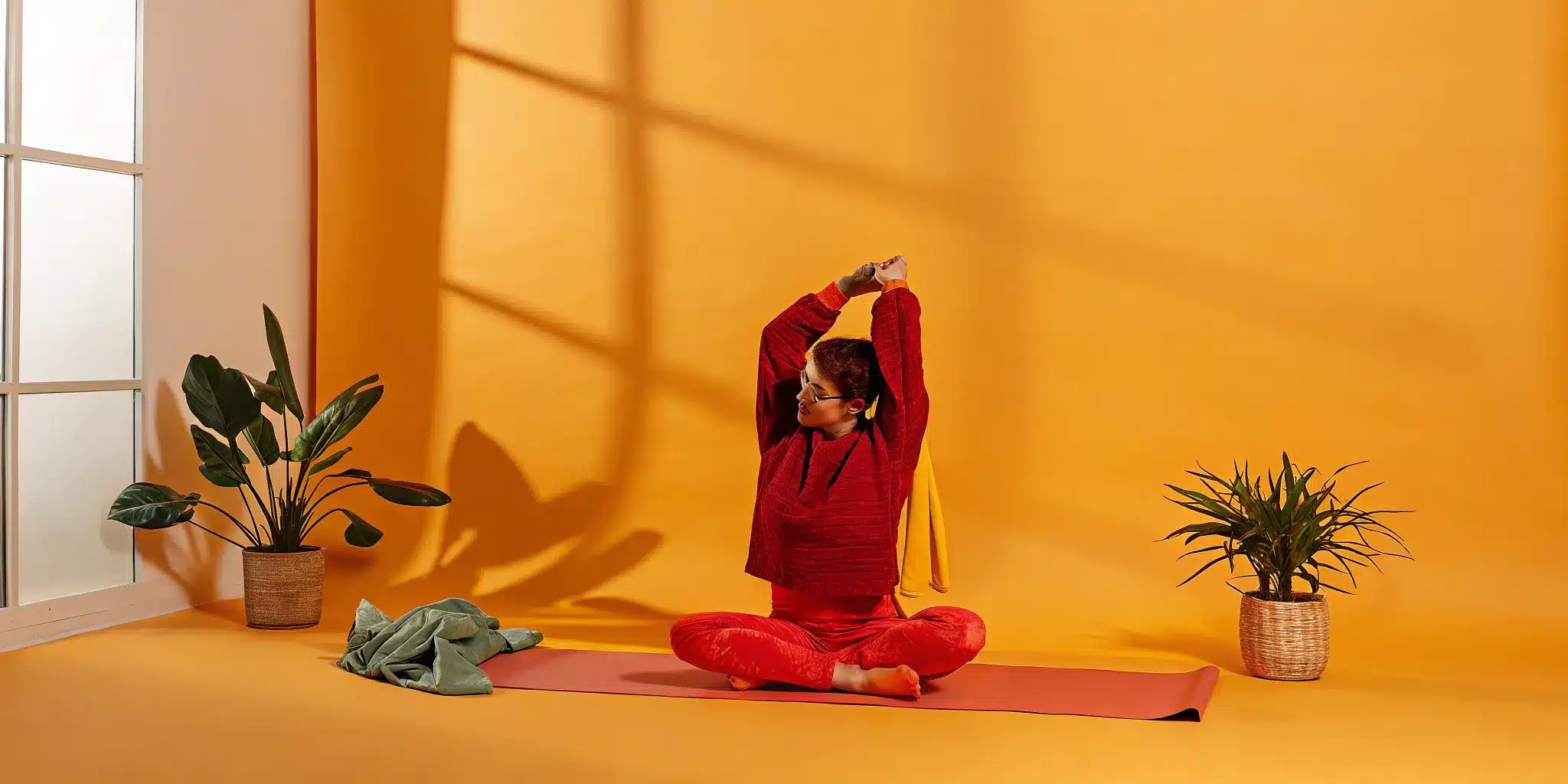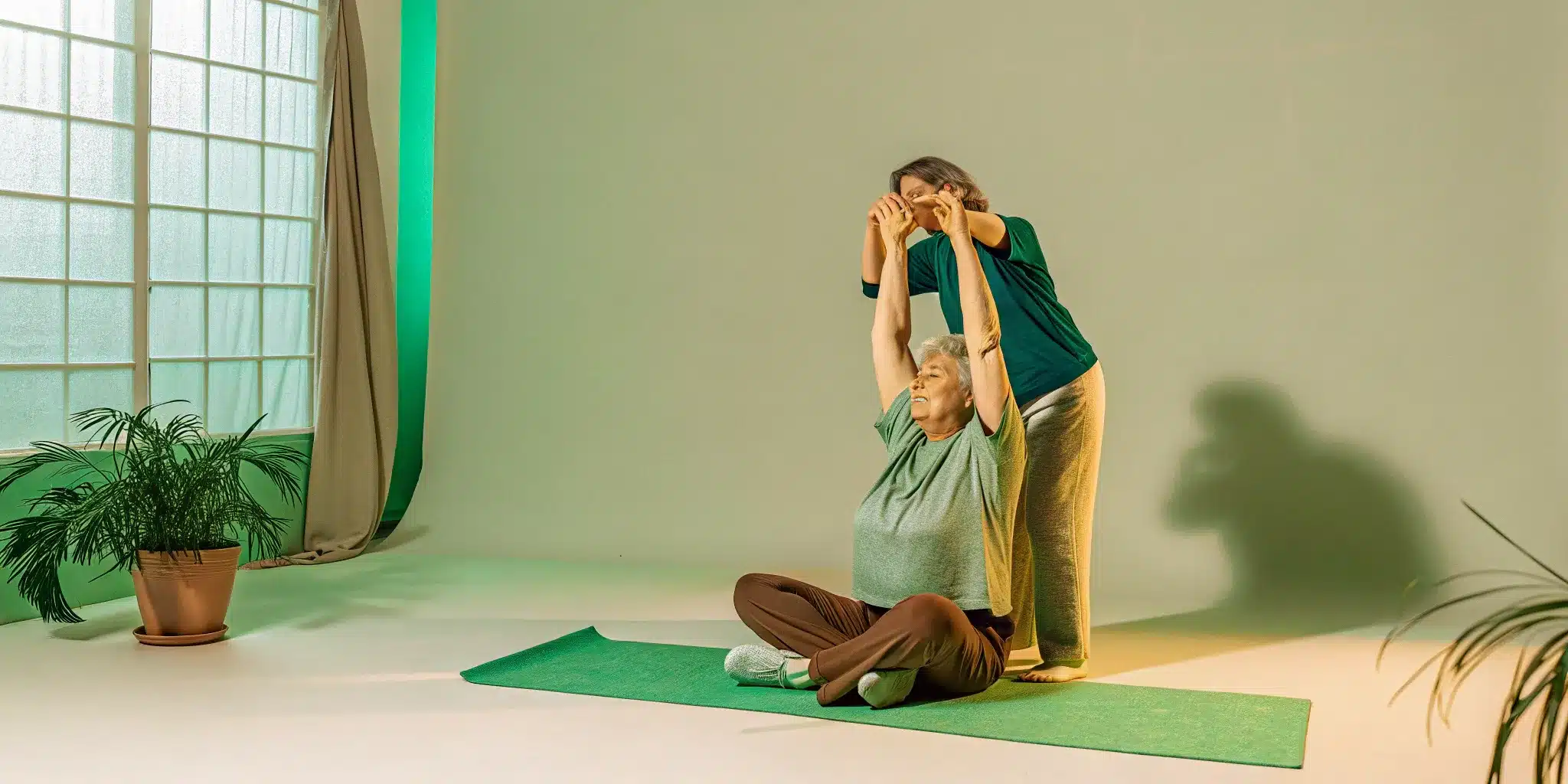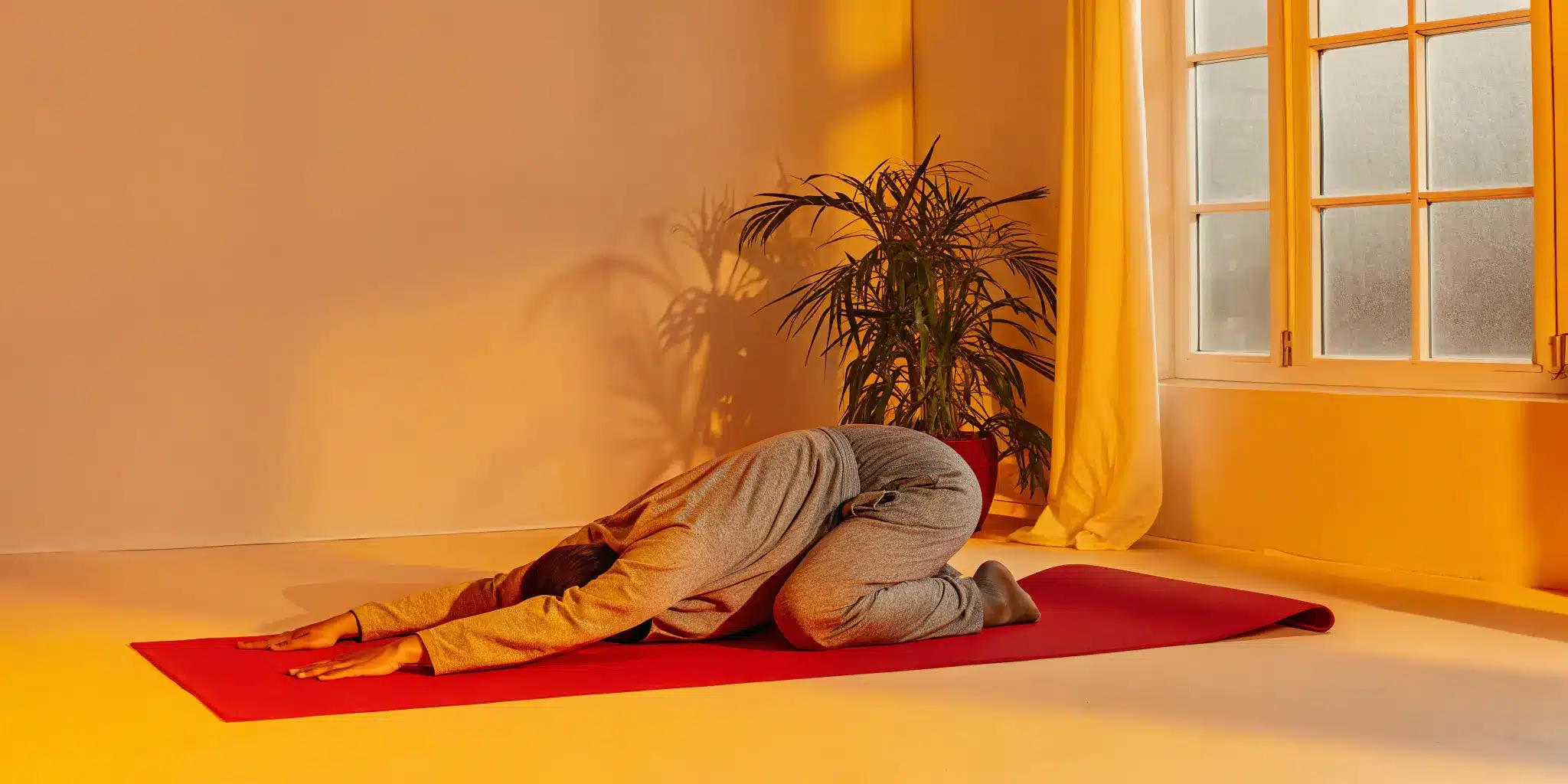When you stretch, are you just pulling on a muscle, or are you actually communicating with it? PNF stretching is a powerful technique built on the idea that real flexibility comes from a dialogue with your nervous system, not from force. The official pnf stretching definition is Proprioceptive Neuromuscular Facilitation—a technical way of saying it uses your nerve-and-muscle connection to make stretching easier and more effective. It involves a specific cycle of contracting and relaxing that essentially persuades your muscles to let go of deep-seated tension. In this guide, we’ll break down exactly how this science works and how you can use it to find more freedom in your movement.
Key Takeaways
- Engage Your Muscles to Release Them: PNF stretching is an active process. By using a specific contract-and-relax cycle, you signal your nervous system to release tension, allowing muscles to lengthen more effectively than with a simple static hold.
- Build Strength and Mobility Together: This technique does more than just improve flexibility. The active contraction phase helps build functional strength, which supports your joints, eases chronic pain, and helps you move with more confidence and control in your daily life.
- Work with a Professional for Safe Progress: To be done correctly and safely, PNF requires a knowledgeable partner. A trained professional provides the right resistance and guidance, ensuring you get a deeper, more productive stretch without risking injury.
What is PNF Stretching?
If you’ve ever felt like you’ve hit a plateau with your flexibility or that regular stretching just isn’t cutting it for your chronic tightness, you might be ready for a more advanced approach. PNF stretching is a powerful technique that goes beyond simply holding a pose. It’s an active form of assisted stretching that involves specific patterns of muscle contracting and relaxing. Think of it as a conversation with your nervous system, teaching your muscles that it’s safe to relax and lengthen. This method can lead to more significant gains in flexibility and range of motion compared to other types of stretching, making it a go-to for physical therapists, trainers, and anyone looking to move more freely and with less pain.
What Does PNF Stand For?
PNF is short for Proprioceptive Neuromuscular Facilitation. That’s a mouthful, so let’s break it down. Proprioception refers to your body’s ability to sense its own position in space. Neuromuscular describes the connection between your nerves and muscles. And Facilitation simply means to make something easier. So, PNF is a method that uses your nerve-and-muscle connection to make stretching easier and more effective. It’s a form of assisted stretching that combines passive stretching (where a partner or tool helps you) with a muscle contraction, essentially tricking your muscles into relaxing more deeply than they normally would.
How Does PNF Work?
The magic of PNF stretching lies in how it communicates with your nervous system. The technique typically involves a sequence where you stretch a muscle, then contract it against resistance for a few seconds, and finally relax into a deeper stretch. This contract-relax cycle activates special sensors in your muscles and tendons. These sensors send signals to your brain that it’s safe to release tension, allowing the muscle to lengthen further. Scientists have a few theories about the precise mechanisms behind why it’s so effective, but it all comes down to overriding the natural “stretch reflex” that causes muscles to tighten up when they feel threatened.
PNF vs. Traditional Stretching
When most of us think of stretching, we picture traditional static stretching—holding a position for 30 seconds or so. While that’s beneficial, PNF takes it to another level. The key difference is the active muscle contraction. Static stretching is passive, but PNF actively engages the target muscle, which leads to a greater relaxation response afterward. Studies consistently show that PNF stretching is more effective than static stretches for making real, lasting improvements in flexibility and range of motion. If you feel stuck in your progress or need to address significant muscle tightness, PNF can help you achieve a breakthrough.
How PNF Stretching Works Step-by-Step
PNF stretching might sound complex, but the process itself is quite intuitive. It’s a conversation between you, your practitioner, and your own nervous system. By moving through a specific sequence, we can gently persuade your muscles to relax and lengthen, helping you find a greater range of motion than you thought possible. Let’s walk through exactly what’s happening in your body during a PNF stretch.
The Stretch-Contract-Relax Cycle
At the heart of every PNF technique is a simple, three-step process. First, your practitioner will guide your muscle into a passive stretch, just to the point where you feel a light tension. Next, you’ll be asked to gently contract that same muscle against their resistance for a few seconds—this is the “work” phase. The magic happens in the final step: as you relax the contraction, your practitioner will guide you into a new, deeper stretch. This PNF stretching sequence allows your muscle to release more effectively than it would with a simple static hold.
How Your Nerves and Muscles Communicate
So, why does that contract-relax cycle work so well? It’s all about how your muscles and nerves talk to each other. Your muscles contain tiny sensors called Golgi tendon organs (GTOs). When you contract your muscle against resistance, it activates these sensors. In response, the GTOs send a signal to your nervous system that basically says, “It’s safe to relax now.” This signal overrides the muscle’s natural tendency to tense up when stretched, allowing it to lengthen. This neurological trick is what allows for such noticeable gains in flexibility during a session.
Why Breathing Matters
Your breath is a powerful tool for relaxation, and it plays a key role in making PNF stretching effective. When you take slow, deep breaths, you signal to your body that it’s safe to let go of tension. During your session, your practitioner will guide you to exhale as you move into the deeper stretch of the cycle. This conscious breathing helps calm your nervous system and enhances the effectiveness of the stretch, allowing your muscles to release more fully. It’s a simple adjustment that makes a world of difference in your results.
Build Better Muscle Memory
The benefits of PNF stretching aren’t just temporary. With consistency, you’re actually retraining your body. Each session helps develop muscle memory, teaching your neuromuscular system to accept and maintain a greater range of motion as its new normal. Over time, your body learns to hold this new flexibility, which means less stiffness and more freedom in your daily movements. This isn’t just about getting a good stretch; it’s about creating lasting change that helps you move well and feel better every day.
The Core PNF Stretching Techniques
PNF stretching might sound technical, but the methods themselves are built around a simple, intuitive cycle of stretching and contracting your muscles. Think of it as a conversation with your body, where you gently coax your muscles into a deeper state of release. There are a few core techniques, each with a slightly different approach to this cycle. Understanding them can help you get the most out of your assisted stretching sessions and appreciate the science behind why it feels so good.
Hold-Relax
This is one of the most common PNF techniques. It starts with your practitioner gently stretching a target muscle to the point of light tension, where you’ll hold for a few seconds. Next, you’ll contract that same muscle against their resistance without actually moving—this is called an isometric contraction. Imagine trying to push your leg down while your practitioner holds it firmly in place. After holding that contraction for about 6-10 seconds, you relax completely. As you exhale, your practitioner will guide you into a deeper stretch, and you’ll likely be surprised by how much further you can go. This PNF stretching technique is fantastic for easing into more flexibility.
Contract-Relax
The Contract-Relax method is a close cousin to Hold-Relax. The process starts the same way, with a passive stretch. However, during the contraction phase, instead of just holding against resistance, you’ll actively move through the full range of motion while your practitioner provides resistance. For example, if you’re stretching your hamstring, you would slowly push your leg down toward the floor against their gentle pressure. After the contraction, you relax, and your practitioner eases the muscle into a new, deeper stretch. This approach helps build strength through the range of motion while simultaneously increasing your flexibility.
Hold-Relax-Contract
This technique adds one final step to the process for maximum results. It follows the same initial steps as Hold-Relax: a passive stretch, followed by an isometric contraction against resistance. But after you relax, there’s one more action. You will actively contract the opposing muscle to pull yourself deeper into the stretch. For a hamstring stretch, this would mean engaging your hip flexors and quads to lift your leg higher. Your practitioner assists this movement, helping you achieve an even greater range of motion. This method leverages a principle called reciprocal inhibition, where contracting one muscle helps its opposite relax more fully.
Stretching With a Partner vs. On Your Own
While you can try to modify some PNF stretches on your own with a strap or towel, this method truly shines when performed with a knowledgeable partner. A trained professional, like our practitioners at StretchMed, can provide the precise amount of resistance needed and guide you safely into a deeper stretch without risking injury. They ensure you’re using the correct form and can adjust the intensity based on your body’s feedback. Stretching with a partner removes the guesswork and allows you to fully relax into the stretch, which is essential for releasing tension and making real progress in your mobility and pain relief journey.
What Are the Benefits of PNF Stretching?
PNF stretching is much more than a simple way to touch your toes. It’s an active technique that uses your body’s own reflexes to create lasting change. By moving through a cycle of stretching and contracting, you can achieve deeper, more effective results than with other methods. This approach helps with everything from everyday stiffness to athletic performance, making it a powerful tool for anyone looking to move and feel better.
Improve Flexibility and Range of Motion
If you feel like your muscles are holding you back, PNF can help. This technique is specifically designed to make muscles more flexible and increase your range of motion, or how far your joints can move comfortably. By engaging the muscle during the stretch, you signal to your nervous system that it’s safe to relax and lengthen. This allows for a deeper, more significant release than you might get from just holding a static stretch. Over time, this can help you move with more freedom and less restriction in your daily activities.
Build Functional Strength
PNF isn’t just about flexibility; it’s also a gentle way to build strength. The “contract” phase of the cycle requires you to actively engage the muscle you’re stretching. This resistance work helps strengthen the muscle in its lengthened position. PNF is a powerful technique for improving flexibility, increasing range of motion, and boosting muscle strength at the same time. This functional strength supports your joints and contributes to better posture and stability, making everyday movements feel stronger and more controlled.
Find Relief From Chronic Pain
For those of us dealing with chronic pain, tight muscles are often a major contributor. PNF stretching can help alleviate muscle tension and promote deep relaxation in overworked areas like the hips, shoulders, and back. Because it works with your nervous system, it can help break the cycle of pain and tightness that so many people experience. By gently encouraging muscles to release, PNF offers a sense of relief and makes movement feel easier and more comfortable.
Speed Up Recovery and Rehabilitation
Whether you’re recovering from a tough workout or rehabilitating an injury, PNF can support the process. Research shows that PNF is effective in restoring and maintaining range of motion, which is crucial for healing properly. It also helps increase muscular strength and power after exercise, reducing soreness and helping your body bounce back faster. This means you can get back to your routine with less downtime and a reduced risk of re-injury.
Improve Athletic Performance
Athletes are always looking for an edge, and PNF stretching delivers. It’s widely considered one of the most effective ways of improving flexibility and increasing range of motion. When your muscles are both flexible and strong, you can move more efficiently, generate more power, and reduce your risk of injury. This translates to better performance, whether you’re running a marathon, playing a round of golf, or just keeping up with your kids in the backyard.
How to Practice PNF Stretching Safely
PNF stretching is an incredibly effective way to improve your flexibility and reduce pain, but its power comes from its precision. Because it involves actively contracting your muscles against resistance, doing it correctly is key to getting the results you want without risking injury. Think of it less like a casual stretch and more like a specific training technique. The good news is that with the right approach and a focus on safety, you can make PNF a game-changer for your body. Prioritizing proper form and listening to your body’s signals will ensure you have a positive and productive experience.
Why You Need a Professional’s Help
Because PNF is a more advanced technique, it’s not something you should try to figure out from a YouTube video alone. Working with a trained professional, like a physical therapist or a certified stretch practitioner, is the best way to learn the ropes. They can provide the external resistance needed for the muscle contractions, ensure your form is correct, and make sure you’re targeting the right muscles. A professional can also teach you how to listen to your body’s cues and distinguish between a productive stretch and one that’s pushing you too far. This guidance is invaluable for preventing injury and getting the maximum benefit from every session.
How to Warm Up Before You Stretch
Never jump into PNF stretching with cold muscles. Your muscles are much more pliable and responsive when they’re warm, which makes them less susceptible to strains or tears. Think of a rubber band—a cold one might snap, but a warm one stretches easily. You don’t need an intense workout beforehand; the goal is just to get your blood flowing. A simple 5-to-10-minute warm-up will do the trick. This could be a brisk walk, some light jogging, or a few minutes on a stationary bike. Doing some dynamic stretches like leg swings or arm circles can also prepare your body for the focused work of PNF.
Common Mistakes to Avoid
When you’re new to PNF, it’s easy to make a few common mistakes. The biggest one is pushing too hard, too soon. PNF is not about forcing your body into a deep stretch; it’s about communicating with your nervous system. You should feel a strong stretch and muscle contraction, but never sharp pain. Another common error is holding your breath. Proper breathing helps your muscles relax, so be sure to exhale as you deepen the stretch. Finally, remember that consistency is more important than intensity. It’s better to do a gentle, correct PNF session than to push your limits and end up with an injury that sets you back.
Is PNF Stretching Right for Everyone?
While PNF stretching is safe and beneficial for most people, it’s not suitable for everyone. If you’re recovering from a recent injury or surgery, you should get clearance from your doctor or physical therapist before trying it. People with certain health conditions, such as uncontrolled high blood pressure, osteoporosis, or joint hypermobility, should also exercise caution. The intense muscle contractions involved in PNF can put stress on bones, joints, and the cardiovascular system. The most important thing is to be honest about your health history. When in doubt, a quick consultation with a healthcare provider can help you determine if PNF is a safe choice for you.
How to Modify Stretches for Your Body
Every body is different, and your PNF routine should reflect that. The beauty of this technique is that it’s highly adaptable. You can modify any stretch by changing the intensity of your muscle contraction or the depth of the stretch itself. For example, during the “contract” phase, you don’t have to push with 100% of your strength. A 50% or 60% contraction can be just as effective, especially when you’re starting out. The goal is to feel the muscle engage, not to fight a war with your own body. A qualified professional can show you how to make these adjustments to fit your unique needs and help you progress safely.
Fit PNF Stretching Into Your Routine
One of the best things about PNF stretching is its versatility. It’s not a one-size-fits-all technique that you have to squeeze into a rigid schedule. Instead, you can weave it into your existing fitness and wellness habits in a way that feels natural and supports your specific goals. Whether you’re looking to get more out of your workouts, recover from an injury, or simply move through your day with less pain, there’s a perfect time and place for PNF. Let’s explore how you can make it a seamless part of your routine.
Before Your Workout
If you want to prepare your body for a great workout, adding PNF stretching to your warm-up is a fantastic move. Think of it as a conversation with your muscles before the main event. This technique helps wake up your muscles and improve coordination, which can lead to better performance and a lower risk of injury. By activating specific muscle groups, you’re essentially priming them for the work ahead. This helps you move more efficiently and with greater control, whether you’re lifting weights, going for a run, or playing a sport. A proper warm-up routine is key, and PNF can be a powerful component.
For Post-Workout Recovery
After you’ve put your body through its paces, PNF stretching can be an incredible tool for recovery. Your muscles are already warm and pliable, making it the perfect time to work on increasing your flexibility and releasing built-up tension. A post-workout PNF session helps soothe sore muscles and encourages relaxation, which can reduce that next-day stiffness. It’s a proactive way to support your body’s natural repair process and promote muscle recovery. By gently lengthening the muscles you just worked, you’re helping them return to a resting state, which aids in their long-term health and resilience.
As Part of a Rehabilitation Plan
PNF stretching originally began as a therapeutic technique to help patients recover from neuromuscular conditions, and its roots in rehabilitation are still one of its greatest strengths. If you’re dealing with an injury or managing chronic pain, PNF can be a game-changer. It’s highly effective at improving muscle elasticity and has been shown to have a positive impact on both active and passive range of motion. Because it’s so targeted, it can help restore function and mobility to specific areas of the body. This is where working with a trained professional is essential to ensure you’re performing the stretches safely and effectively for your condition.
Create Your PNF Stretching Schedule
Like any healthy habit, consistency is what brings real, lasting results. You don’t need to practice PNF stretching every day to feel the benefits, but aiming for at least two sessions per week is a great starting point. The key is to find a rhythm that fits your life. You might schedule your PNF sessions after your regular workouts or set aside dedicated time on your recovery days. The important thing is to make it a non-negotiable part of your week. A professional can help you design a personalized schedule that aligns with your goals and ensures you’re getting the most out of every stretch.
How to Track Your Progress
Staying motivated is much easier when you can see how far you’ve come. Tracking your progress with PNF stretching doesn’t have to be complicated. You can keep a simple journal to note how you feel before and after each session. Are you noticing less tension in your shoulders? Can you bend down to tie your shoes with more ease? You can also take simple measurements, like how far you can reach in a hamstring stretch. Celebrating these small wins makes the journey more rewarding and helps you stay committed. Seeing tangible improvements in your flexibility and feeling a decrease in daily aches and pains is the best motivation to keep going.
PNF vs. Other Types of Stretching
If you’ve ever been to a gym or a yoga class, you’re probably familiar with a few different ways to stretch. While most methods can help you feel a little looser, PNF stretching works differently to create more significant and lasting changes in your flexibility and mobility. Understanding how it stacks up against more traditional stretching can help you see why it’s such a powerful tool for everything from pain relief to athletic performance. Let’s look at how PNF compares to the two most common types of stretching: static and dynamic.
PNF vs. Static Stretching
Static stretching is likely what you picture when you think of stretching—holding a position for 20-30 seconds to lengthen a muscle. It’s simple and can be effective for a post-workout cool-down. PNF, however, is an active process. By incorporating an isometric contraction (the “contract-relax” cycle), you’re essentially telling your nervous system it’s safe to let the muscle lengthen further. This is why research shows PNF is often more effective than static stretching for making real improvements in your range of motion and even increasing muscular strength. It goes beyond a simple pull to actively retrain your muscle reflexes.
PNF vs. Dynamic Stretching
Dynamic stretching involves moving your body through a full range of motion to prepare for an activity, like doing arm circles before a swim or leg swings before a run. It’s an excellent way to warm up your muscles and get your body ready for a workout. PNF is different because it combines passive stretching with that muscle contraction. While dynamic stretching is about movement and preparation, PNF is a targeted technique designed to achieve a deeper stretch and improve flexibility more rapidly. Think of dynamic stretching as your warm-up and PNF as your dedicated flexibility training.
Choose the Right Stretch for Your Goals
So, which type of stretching should you do? It all depends on your goals. Dynamic stretching is the clear winner for warming up before a workout. Static stretching can be a gentle way to cool down and maintain your current flexibility. But if you have specific goals—like recovering from an injury, increasing your range of motion to relieve chronic pain, or improving your athletic performance—PNF offers a more tailored and effective approach. It’s the best choice when you want to make measurable progress in how your body moves and feels.
What You Need to Get Started
Ready to give PNF a try? The most important rule is to never perform PNF stretching on cold muscles. Your muscles are most receptive to this technique when they’re warm, so it’s best to do it after a workout or after some light activity like a brisk walk. Because the technique is so specific, working with a trained professional is the safest and most effective way to learn. A professional can guide you through the movements, ensure you’re using the correct form, and help you get the most out of every session without risking injury.
Ready to Try PNF Stretching?
If you’re excited about the possibility of greater flexibility and less pain, the next step is to put PNF stretching into practice safely and effectively. Getting started the right way is key to seeing real, lasting results without risking injury. Here’s how you can begin.
Find a Qualified Professional
Because PNF is an advanced technique, it’s not something you should try to figure out alone. Working with a trained professional is the best and safest way to learn. A certified stretch therapist can guide you through the movements, ensure you’re using proper form, and tailor the stretches to your body’s specific needs. They’ll act as your partner, providing the necessary resistance and making sure you get the most out of every session. This hands-on guidance is what makes 1-on-1 assisted stretching so effective for learning complex techniques like PNF.
Build a Safe and Effective Routine
Safety and proper form are non-negotiable with PNF. While a professional will guide you, there are a few universal rules. First, always warm up. PNF should never be performed on cold muscles, as this increases the risk of strains or tears. A few minutes of light cardio, like walking or cycling, is enough to get your blood flowing. Your guide will also teach you how to listen to your body and recognize the difference between a deep, productive stretch and pain that signals you’re pushing too far.
Set Realistic Goals for Your Body
PNF stretching offers a tailored approach to help you reach your flexibility goals, whether you want to touch your toes or reduce lower back pain. PNF can target specific muscle groups to help you get there, making it a powerful tool for improving mobility beyond what static stretching alone can achieve. Remember to be patient with yourself. Progress takes time, and setting small, achievable goals will keep you motivated as you work toward greater freedom of movement.
See and Feel Your Progress
You won’t just feel the difference with PNF—you’ll see it. As you continue your routine, you’ll notice a real improvement in your range of motion and functional strength. Research shows that PNF is highly effective for not only improving flexibility but also for increasing muscular power. Soon, everyday movements will feel easier, from reaching for a high shelf to getting out of a chair without stiffness. Tracking this progress can be incredibly rewarding and confirms that your hard work is paying off.
Related Articles
- What is PNF Stretching? A Simple Guide for Beginners – STRETCHMED
- What is PNF Stretching? The Complete Guide – STRETCHMED
- PNF Stretching Exercises: The Ultimate Guide for Beginners – STRETCHMED
Frequently Asked Questions
Is PNF stretching supposed to hurt? Absolutely not. While PNF involves a deep stretch and an active muscle contraction, it should never cause sharp or shooting pain. You should feel a strong sensation of tension and release, but it should always feel productive and safe. A trained professional will communicate with you throughout the session to ensure you stay within a comfortable and effective range, distinguishing between a good stretch and a sign to ease up.
How often should I do PNF stretching to see results? Consistency is more important than frequency. While you can feel an immediate increase in your range of motion after just one session, lasting changes come from regular practice. For most people, incorporating PNF stretching into their routine two to three times a week is a great goal. This gives your body time to adapt and build new muscle memory without overdoing it.
Why can’t I just do these stretches on my own at home? PNF stretching relies on precise resistance and expert guidance to be both safe and effective. A trained practitioner knows exactly how much pressure to apply during the contraction phase and how to guide you into a deeper stretch without forcing the muscle. This partnership removes the guesswork and allows your body to fully relax, which is something that’s very difficult to achieve on your own.
I’m not an athlete. Can PNF stretching still help me? Definitely. PNF was originally developed in a clinical setting for rehabilitation, not for athletic performance. It’s an incredibly powerful tool for anyone dealing with chronic tightness, stiffness from sitting at a desk, or general aches and pains. The goal is to help you move more freely and with less discomfort in your everyday life, whether that means bending down to pick something up or simply walking with more ease.
How is PNF different from the deep stretching I do in a yoga class? While some yoga poses involve long holds similar to static stretching, PNF is a more active process. The key difference is the “contract-relax” cycle. In PNF, you actively engage the muscle you are stretching against resistance before relaxing into a deeper stretch. This active engagement communicates with your nervous system in a unique way, allowing for a more significant and immediate release of tension than a passive hold alone can provide.








